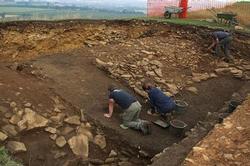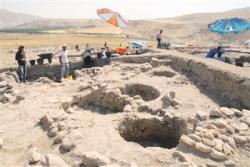INSTITUT SUPERIEUR D'ANTHROPOLOGIE
INSTITUTE OF ANTHROPOLOGY
ONLINE COURSES / COURS A DISTANCE
FALL TERM : OCTOBER 2013
REGISTER NOW
INDE –  Palakole - Authorities in Andhra Pradesh have discovered four French gold coins dating back to Napoleon III, the nephew of Napoleon Bonaparte and the last monarch of France, in a temple. The coins, each weighing 1.5 grams, were found during digging at the Ksheera Ramalingeswara Swamy temple at Palakole town in West Godavari in coastal Andhra. Department of archaeology and museums assistant director Bangaiah told IANS over phone that the coins dating back to the 18th century A.D. have images of Napoleon III. "This is the first time that French coins have been found in Andhra Pradesh," said Bangaiah. He pointed out that Palakole was a trading centre on the eastern coast attracting the Dutch, the French, the Portuguese and the British traders. The official said the coins were found during the excavation work to rebuild the 'dhwajastambham' at the 10th century temple. The dhwajastambham or flag post of the deity had collapsed during the recent rains and the temple authorities had taken up the excavation to reinstall it. "As per custom, the coins and other valuables of the temple are kept in a pit before erecting the dhwajastambham," said Bangaiah.
Palakole - Authorities in Andhra Pradesh have discovered four French gold coins dating back to Napoleon III, the nephew of Napoleon Bonaparte and the last monarch of France, in a temple. The coins, each weighing 1.5 grams, were found during digging at the Ksheera Ramalingeswara Swamy temple at Palakole town in West Godavari in coastal Andhra. Department of archaeology and museums assistant director Bangaiah told IANS over phone that the coins dating back to the 18th century A.D. have images of Napoleon III. "This is the first time that French coins have been found in Andhra Pradesh," said Bangaiah. He pointed out that Palakole was a trading centre on the eastern coast attracting the Dutch, the French, the Portuguese and the British traders. The official said the coins were found during the excavation work to rebuild the 'dhwajastambham' at the 10th century temple. The dhwajastambham or flag post of the deity had collapsed during the recent rains and the temple authorities had taken up the excavation to reinstall it. "As per custom, the coins and other valuables of the temple are kept in a pit before erecting the dhwajastambham," said Bangaiah.
http://www.business-standard.com/article/news-ians/four-napoleon-iii-era-coins-discovered-in-andhra-temple-113090200794_1.html
ROYAUME UNI –  Ham Hill - Human remains more than 2,500 years old have been discovered by archaeologists from Cardiff and Cambridge universities during their final season of excavations at the UK’s largest Iron Age hillfort. Over the last three summers, Niall Sharples of Cardiff’s School of History, Archaeology and Religion and Christopher Evans of the Cambridge Archaeological Unit have led a team excavating an extensive area of Ham Hill in Somerset. Trial excavations at the start of the project revealed one Iron Age skeleton and this year’s dig has revealed further remains. "Ham Hill overlooks the county’s marshland levels, and in thoroughly green and pleasant lands, its picturesque setting certainly jars against the number of human remains that are being found," said Christopher Evans. "Our work this year is concentrated on an area of the hillfort constructed at the end of the Iron Age to (unsuccessfully) defend the hillfort against the oncoming Romans. It consists of an imposing box-revetted stone rampart set on top of earlier earthen banks. Human remains in the deposits behind it, evinces a violent assault and these remains appear to have been de-fleshed or chopped up and left exposed on the surface. Roman military items have also been discovered and the hill-top may well have been garrisoned in the initial period of the Roman occupation of the South West," added Christopher. Hillforts are one of the most common and widespread monuments of British prehistory, and the team has been given special permission to excavate Ham Hill. Their work has provided an understanding of the hillfort’s enormous ramparts and given an insight into Iron Age life at the site. Niall Sharples said: "The excavated enclosure does not seem to have been occupied but was a largely empty and short-lived space, appearing to have been deliberately destroyed, perhaps after only 5-10 years. "It could have been a meeting place, maybe for the community to gather to make decisions. Another reason for thinking that this was a special place is the quantity of human remains. Several burials have been discovered, in pits and within the enclosure ditch. Fragments of human skull and other isolated bones have also been recovered that appear to have been scattered across the area, possibly circulated as tangible representations of ancestors. Perhaps these ancestors were called upon when important decisions had to be made?"
Ham Hill - Human remains more than 2,500 years old have been discovered by archaeologists from Cardiff and Cambridge universities during their final season of excavations at the UK’s largest Iron Age hillfort. Over the last three summers, Niall Sharples of Cardiff’s School of History, Archaeology and Religion and Christopher Evans of the Cambridge Archaeological Unit have led a team excavating an extensive area of Ham Hill in Somerset. Trial excavations at the start of the project revealed one Iron Age skeleton and this year’s dig has revealed further remains. "Ham Hill overlooks the county’s marshland levels, and in thoroughly green and pleasant lands, its picturesque setting certainly jars against the number of human remains that are being found," said Christopher Evans. "Our work this year is concentrated on an area of the hillfort constructed at the end of the Iron Age to (unsuccessfully) defend the hillfort against the oncoming Romans. It consists of an imposing box-revetted stone rampart set on top of earlier earthen banks. Human remains in the deposits behind it, evinces a violent assault and these remains appear to have been de-fleshed or chopped up and left exposed on the surface. Roman military items have also been discovered and the hill-top may well have been garrisoned in the initial period of the Roman occupation of the South West," added Christopher. Hillforts are one of the most common and widespread monuments of British prehistory, and the team has been given special permission to excavate Ham Hill. Their work has provided an understanding of the hillfort’s enormous ramparts and given an insight into Iron Age life at the site. Niall Sharples said: "The excavated enclosure does not seem to have been occupied but was a largely empty and short-lived space, appearing to have been deliberately destroyed, perhaps after only 5-10 years. "It could have been a meeting place, maybe for the community to gather to make decisions. Another reason for thinking that this was a special place is the quantity of human remains. Several burials have been discovered, in pits and within the enclosure ditch. Fragments of human skull and other isolated bones have also been recovered that appear to have been scattered across the area, possibly circulated as tangible representations of ancestors. Perhaps these ancestors were called upon when important decisions had to be made?"
http://www.newswales.co.uk/index.cfm?section=Education&F=1&id=26104
ROUMANIE –  - Declassified spy photographs have helped archaeologists uncover the lost history of a Roman wall dating from the second century AD. Archaeologists studying images gathered during covert intelligence operations in the last century have identified a wall that ran around 37 miles from the Danube to the Black Sea over what is now Romania. Built in the mid-second century, the barrier once stood 28ft wide and around 11.5ft high and included at least 32 forts and 31 smaller buildings along its course. It is thought to have served a similar purpose to other Roman frontiers such as Hadrian's Wall, built to defend the Roman Empire from threats to the borders. Known locally as Trajan's Rampart, it consists of three separate walls which were wrongly dated to the Byzantine or early medieval period. The research was carried out by archaeologists at the universities of Glasgow and Exeter who believe that studying declassified photographs taken during covert surveillance may help uncover and identify thousands of archaeological sites around the world.
- Declassified spy photographs have helped archaeologists uncover the lost history of a Roman wall dating from the second century AD. Archaeologists studying images gathered during covert intelligence operations in the last century have identified a wall that ran around 37 miles from the Danube to the Black Sea over what is now Romania. Built in the mid-second century, the barrier once stood 28ft wide and around 11.5ft high and included at least 32 forts and 31 smaller buildings along its course. It is thought to have served a similar purpose to other Roman frontiers such as Hadrian's Wall, built to defend the Roman Empire from threats to the borders. Known locally as Trajan's Rampart, it consists of three separate walls which were wrongly dated to the Byzantine or early medieval period. The research was carried out by archaeologists at the universities of Glasgow and Exeter who believe that studying declassified photographs taken during covert surveillance may help uncover and identify thousands of archaeological sites around the world.
http://www.perthshireadvertiser.co.uk/perthshire-news/scottish-news/2013/09/02/roman-wall-revealed-in-spy-photos-73103-33800680/
TURQUIE –  Hasankeyf - Excavations carried out by a Japanese team in Batman’s ancient city of Hasankeyf have revealed painted graves from the Neolithic age 11,500 years ago. Human skeletons were found in the graves. This year 18 painted graves from the Neolithic age were discovered in the Hasankeyf tumulus. Works are still continuing with 12 experts, six students and 40 workers under the scientific consultation of Japanese Tsukuba University’s Professor Yutuka Miyake. Miyake said that the tumulus were from 11,500 years ago, the beginning of the Neolithic age, and continued: “We know this place as the first village founded in the region. People lived the nomadic life here. Sometime later they moved to settled life. There are lots of rounded houses here and people lived there. There is a structure of 9 meters in width. We think that this structure is a special one. There is an obelisk on the floor. We have found the same thing in a tumulus in Siirt. We determined 30 funerary chambers and human skeletons underground. In these times, people used to be buried underground because there were no graveyards. We also found traces of painting on human skeletons. The bones were painted with orange and black.” Miyake said that excavations started on Aug. 15 and 18 human skeletons had been found since then. The number of total human skeletons found amounted to 80 when added to those found last year.
Hasankeyf - Excavations carried out by a Japanese team in Batman’s ancient city of Hasankeyf have revealed painted graves from the Neolithic age 11,500 years ago. Human skeletons were found in the graves. This year 18 painted graves from the Neolithic age were discovered in the Hasankeyf tumulus. Works are still continuing with 12 experts, six students and 40 workers under the scientific consultation of Japanese Tsukuba University’s Professor Yutuka Miyake. Miyake said that the tumulus were from 11,500 years ago, the beginning of the Neolithic age, and continued: “We know this place as the first village founded in the region. People lived the nomadic life here. Sometime later they moved to settled life. There are lots of rounded houses here and people lived there. There is a structure of 9 meters in width. We think that this structure is a special one. There is an obelisk on the floor. We have found the same thing in a tumulus in Siirt. We determined 30 funerary chambers and human skeletons underground. In these times, people used to be buried underground because there were no graveyards. We also found traces of painting on human skeletons. The bones were painted with orange and black.” Miyake said that excavations started on Aug. 15 and 18 human skeletons had been found since then. The number of total human skeletons found amounted to 80 when added to those found last year.
http://www.hurriyetdailynews.com/bones-from-neolithic-era-found-in-turkeys-hasankeyf.aspx?pageID=238&nID=53546&NewsCatID=375